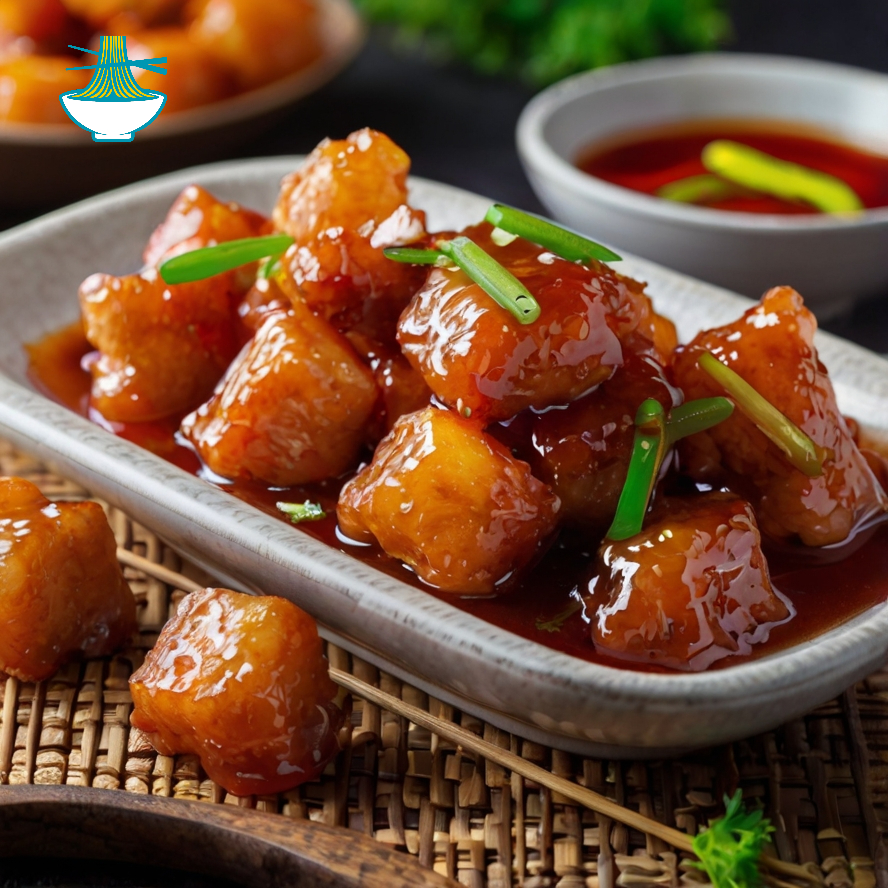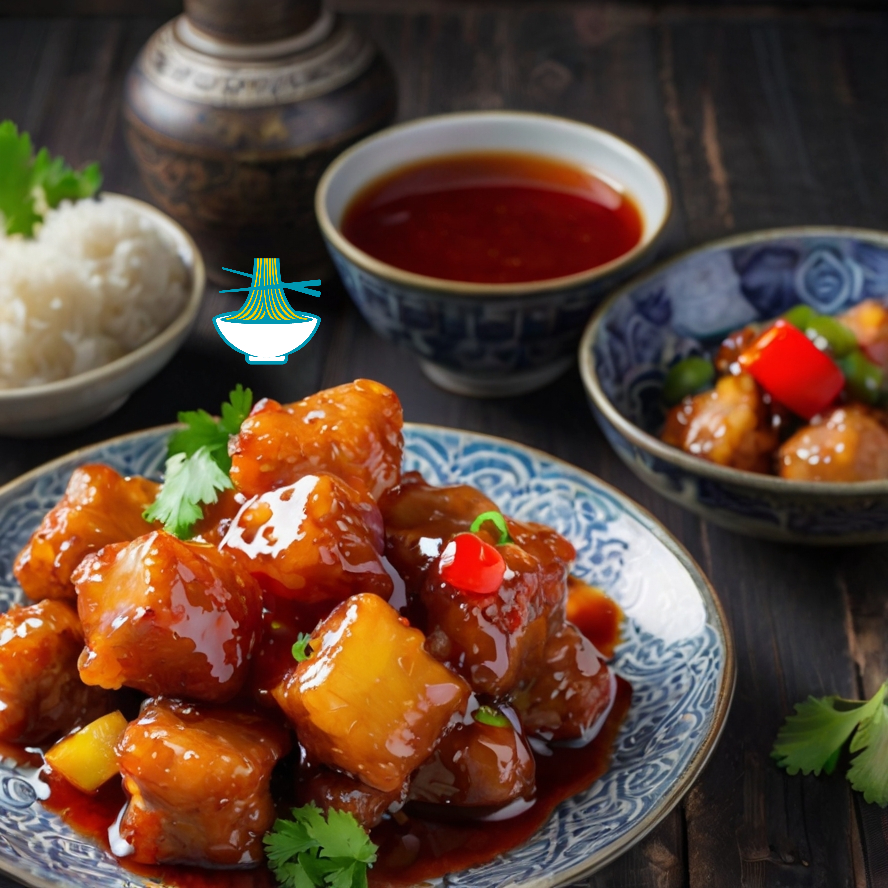Sweet and Sour Pork is a beloved Chinese dish known for its harmonious blend of sweet, tangy, and savory flavors. This dish features crispy, deep-fried pork pieces coated in a vibrant sauce made with vinegar, sugar, and ketchup. It is typically served over steamed rice or noodles and garnished with chopped scallions or sesame seeds. The colorful vegetables such as bell peppers and onions not only enhance the visual appeal but also add a delightful crunch and nutritional value to the dish.

The origins of Sweet and Sour Pork can be traced back to the Guangdong province of China. Traditionally, it was prepared using locally available ingredients like sugar, vinegar, and soy sauce. As the dish gained popularity, it spread to other regions in China and eventually became a global favorite, commonly featured in Chinese restaurants worldwide. The combination of flavors in Sweet and Sour Pork reflects the Chinese culinary philosophy of balancing different tastes, which has contributed to its enduring popularity.
Ingredients:
- 1 pound of boneless pork shoulder or pork tenderloin, cut into bite-size pieces
- 1 egg, beaten
- 1/2 cup of cornstarch
- 1/4 cup of vegetable oil
- 1/4 cup of rice vinegar
- 1/4 cup of ketchup
- 1/4 cup of sugar
- 1/4 cup of chicken broth
- 1 tablespoon of soy sauce
- 1 tablespoon of cornstarch (for the sauce)
- 1 green bell pepper, cut into bite-size pieces
- 1 red bell pepper, cut into bite-size pieces
- 1 small onion, cut into bite-size pieces
- Salt and pepper to taste
Instructions:
1. Prepare the Pork:
- Cut the pork into bite-size pieces and season with salt and pepper.
- In a separate bowl, beat one egg and set aside.
2. Coat the Pork:
- Roll each pork piece in cornstarch until coated evenly.
- Dip the pork pieces in the beaten egg mixture.
3. Fry the Pork:
- In a large skillet or wok, heat the vegetable oil over high heat.
- Once the oil is hot, add the coated pork pieces and cook until crispy and golden brown, about 5-6 minutes.
- Remove the pork and set aside.
4. Make the Sweet and Sour Sauce:
- In a separate bowl, whisk together rice vinegar, ketchup, sugar, chicken broth, soy sauce, and cornstarch until smooth.
5. Cook the Vegetables:
- In the same skillet, add the green and red bell peppers and onion.
- Cook for 2-3 minutes, or until the vegetables are slightly tender.
6. Add the Sauce:
- Pour the sweet and sour sauce into the skillet with the vegetables.
- Stir well and cook for 1-2 minutes until the sauce has thickened.
7. Combine Everything:
- Add the fried pork back to the skillet.
- Stir until the pork is evenly coated with the sauce.
8. Serve:
- Serve the sweet and sour pork hot over steamed rice or noodles.
Notes:
- Safety Tip: Be cautious when frying the pork to avoid oil splashes. Use a splatter screen if available.
- Adjusting Flavor: Adjust the sweetness and tanginess of the sauce according to your preference by adding more sugar or vinegar.
- Variation: For a tropical twist, add pineapple chunks to the dish.
Sweet and Sour Pork is a delightful dish that offers a perfect balance of flavors, making it a favorite among Chinese cuisine enthusiasts worldwide. Enjoy preparing and savoring this delicious meal!

Nutrition Value:
1. 1 pound of boneless pork shoulder or pork tenderloin, cut into bite-size pieces
- Calories: 1040
- Carbohydrates: 0g
- Protein: 100g
- Fat: 70g
- Sodium: 220mg
- Cholesterol: 300mg
- Vitamins: B vitamins (B1, B2, B6, B12)
- Minerals: Zinc, iron, phosphorus
- Nutritional Benefit: High in protein and essential nutrients like B vitamins and minerals that support muscle growth and overall health.
2. 1 egg, beaten
- Calories: 70
- Carbohydrates: 1g
- Protein: 6g
- Fat: 5g
- Sodium: 70mg
- Cholesterol: 185mg
- Vitamins: Vitamin A, D, E, B12
- Minerals: Selenium, phosphorus
- Nutritional Benefit: Provides high-quality protein, essential vitamins, and minerals that support vision, bone health, and immune function.
3. 1/2 cup of cornstarch
- Calories: 240
- Carbohydrates: 58g
- Protein: 0g
- Fat: 0g
- Sodium: 0mg
- Cholesterol: 0mg
- Vitamins: None significant
- Minerals: None significant
- Nutritional Benefit: Acts as a thickening agent; provides quick energy from carbohydrates.
4. 1/4 cup of vegetable oil
- Calories: 480
- Carbohydrates: 0g
- Protein: 0g
- Fat: 54g
- Sodium: 0mg
- Cholesterol: 0mg
- Vitamins: Vitamin E
- Minerals: None significant
- Nutritional Benefit: Source of healthy fats, particularly if using oils like olive or canola, which support heart health.
5. 1/4 cup of rice vinegar
- Calories: 15
- Carbohydrates: 4g
- Protein: 0g
- Fat: 0g
- Sodium: 0mg
- Cholesterol: 0mg
- Vitamins: None significant
- Minerals: None significant
- Nutritional Benefit: Adds tangy flavor with minimal calories; may aid in digestion.
6. 1/4 cup of ketchup
- Calories: 60
- Carbohydrates: 16g
- Protein: 0g
- Fat: 0g
- Sodium: 440mg
- Cholesterol: 0mg
- Vitamins: Vitamin A, C
- Minerals: None significant
- Nutritional Benefit: Adds flavor and some vitamins but should be used in moderation due to high sodium content.
7. 1/4 cup of sugar
- Calories: 200
- Carbohydrates: 50g
- Protein: 0g
- Fat: 0g
- Sodium: 0mg
- Cholesterol: 0mg
- Vitamins: None significant
- Minerals: None significant
- Nutritional Benefit: Provides energy but should be used sparingly due to lack of other nutrients.
8. 1/4 cup of chicken broth
- Calories: 5
- Carbohydrates: 0g
- Protein: 1g
- Fat: 0g
- Sodium: 200mg
- Cholesterol: 0mg
- Vitamins: None significant
- Minerals: Sodium
- Nutritional Benefit: Adds flavor with minimal calories; contains some protein.
9. 1 tablespoon of soy sauce
- Calories: 10
- Carbohydrates: 1g
- Protein: 1g
- Fat: 0g
- Sodium: 920mg
- Cholesterol: 0mg
- Vitamins: None significant
- Minerals: Sodium
- Nutritional Benefit: Adds umami flavor; high in sodium, so use sparingly.
10. 1 tablespoon of cornstarch (for the sauce)
- Calories: 30
- Carbohydrates: 7g
- Protein: 0g
- Fat: 0g
- Sodium: 0mg
- Cholesterol: 0mg
- Vitamins: None significant
- Minerals: None significant
- Nutritional Benefit: Thickening agent with minimal nutritional value.
11. 1 green bell pepper, cut into bite-size pieces
- Calories: 24
- Carbohydrates: 6g
- Protein: 1g
- Fat: 0g
- Sodium: 3mg
- Cholesterol: 0mg
- Vitamins: A, C, K, B6
- Minerals: Potassium
- Nutritional Benefit: Low in calories, high in vitamins and antioxidants, which support immune health and reduce inflammation.
12. 1 red bell pepper, cut into bite-size pieces
- Calories: 24
- Carbohydrates: 6g
- Protein: 1g
- Fat: 0g
- Sodium: 3mg
- Cholesterol: 0mg
- Vitamins: A, C, K, B6
- Minerals: Potassium
- Nutritional Benefit: Similar to green bell pepper, with additional antioxidants like beta-carotene.
13. 1 small onion, cut into bite-size pieces
- Calories: 28
- Carbohydrates: 6g
- Protein: 1g
- Fat: 0g
- Sodium: 2mg
- Cholesterol: 0mg
- Vitamins: C, B6
- Minerals: Potassium
- Nutritional Benefit: Adds flavor and nutrients, supports immune function, and has anti-inflammatory properties.
14. Salt and pepper to taste
- Calories: 0
- Carbohydrates: 0g
- Protein: 0g
- Fat: 0g
- Sodium: Varies
- Cholesterol: 0mg
- Vitamins: None significant
- Minerals: None significant
- Nutritional Benefit: Enhances flavor; use in moderation to control sodium intake.
Sweet and Sour Pork provides a balanced combination of protein, fats, and carbohydrates, with added benefits from vitamins and minerals in the vegetables. The pork and egg offer high-quality protein, while the bell peppers and onions provide essential vitamins and antioxidants. The sauce ingredients add flavor but should be moderated to manage sugar and sodium intake.


Comments